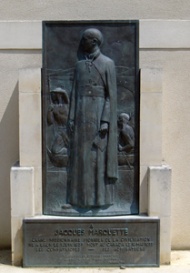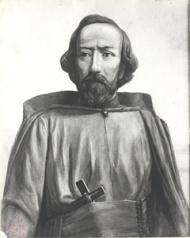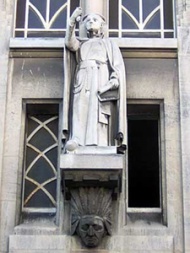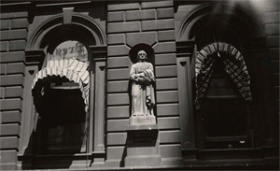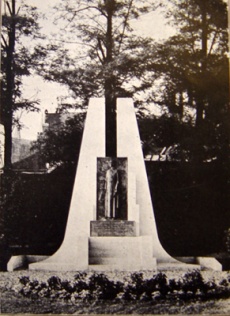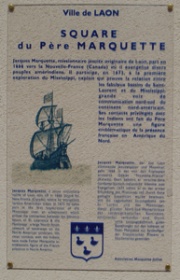Father Marquette Monument in Laon: Commemorating an North American Historical Figure on French soil
par Thierry, Éric
Born in Laon, Northern France, in 1637, the Jesuit priest Jacques Marquette discovered the Mississippi River in 1673, as he explored the region alongside Louis Jolliet, the Quebec-born noble, merchant and explorer. Father Marquette died near the present-day city of Ludington, Michigan, in 1675. When his bones were discovered in 1877, he became a renowned historical figure in the United States, but remained largely unrecognized in France. The story of the monument built in 1937 in Marquette's hometown to honour this North American historical figure illustrates just how whimsical the local memory of him could be. A Jesuit long-disowned in France due to anticlericalism, Father Marquette was honoured in his home country when his historical contributions as an explorer and mapmaker were finally recognised.
Refusing to Honour a Jesuit
The desire to see Laon honour Father Marquette was first expressed in September 1900, during the 12th International Congress of Americanists held in Paris at the Collège de France. Although Henri Cordier specialized in the writings of Jesuit missionaries in China, at the convention he chose to talk about the illustrious Jesuit from Laon. At the start of his presentation, he expressed his dismay at the lack of recognition of Father Marquette by his hometown in Picardy and contrasted it with the acclaim the Jesuit had already received on the other side of the Atlantic: In 1896, the state of Wisconsin had presented the Capitol Building in Washington with a white marble statue by the Italian artist Gaetano Trentanove, and the following year, a bronze replica had been unveiled in a public park in the City of Marquette, Michigan(NOTE 1).
During the closing session of the congress, on September 22, 1900, Henri Cordier's colleagues responded to his call to action and letters were promptly dispatched to Laon. The town authorities responded rapidly with a refusal(NOTE 2). As emotions were once again running high because of the Dreyfus Affair and as anticlericalism was already dominating the deliberations on the proposed Waldeck-Rousseau Associations Act, it was out of the question to honour a member of the Society of Jesus.
In 1903, the French Jesuit Alfred Hamy published a biography of Father Marquette in Paris, in which he expressed the hope of seeing Laon honour the "great explorer of the Mississippi" in the not-too-distant future(NOTE 3). It was only with the 1909 unveiling of a monument on Mackinac Island, Michigan (which was identical to the one in the city of Marquette), as well as the erecting of a column surmounted with an original sculpture of the Jesuit the following year, in Prairie du Chien, Wisconsin, that the interest of some of the inhabitants of Laon was finally awakened. During a session held on October 28, 1910, the Société Académique de Laon expressed its desire to see a statue of Father Marquette erected in his hometown(NOTE 4).
A First Statue in Nancy
The man behind this resolution was Charles Westercamp. He was originally a lawyer and later devoted his energies to journalism, writing novels, and historical research. He was a resident of both Laon and Paris. When in the capital, he kept in touch with other Picardy residents from the French regional department of Aisne-particularly Gabriel Hanoteaux, a diplomat, historian and member of the Académie Française. On January 1, 1909, Hanoteaux created the France-America Committee, whose goal was "to make America better known to France, and France to America"(NOTE 5). He encouraged the learned citizens of Laon to bring Father Marquette out of the forgotten shadows of history.
However, Gabriel Hanoteaux's support was not enough, for it was not long before the start of the First World War kept the Société Académique from making its dream come true. In the end, the first statue was not erected in Father Marquette's hometown, but rather in Nancy, the city where he lived during his Jesuit novitiate. In 1930, the Society of Jesus named the recently constructed building of the Groupe des Étudiants Catholiques [Catholic Student Association] (GEC) after Father Marquette and incorporated a statue of the Jesuit explorer into the façade. The stone sculpture by Victor Huel shows Father Marquette holding a map in one hand and with a raised crucifix in the other. The idea of setting up the statue came from Father Lejosne, chaplain of the Nancy GEC, who wanted his students to become active men of faith.
This portrayal of the Jesuit bears very little resemblance to Trentanove's artistic rendering of the explorer present in the monuments in Washington D.C., in Marquette and on Mackinac Island. These monuments depict a more conventional, ecclesiastical Father Marquette, whose hair, beard and features are identical to those of Father Charlevoix, the 18th-century Jesuit explorer and historian. The statue in Nancy is more like the one erected in 1910, in Prairie du Chien, and it particularly resembles Chicago's Marquette-and-Jolliet monument, erected in 1926. In both sculptures, the Jesuit is holding a crucifix, although in the second, he does not have hair or a beard, but instead is bald and clean-shaven-just as he appears in the 1669 portrait that was discovered around about 1900 in Montreal.
Between the two great world wars, Catholics in the United States and in France were particularly interested in role models that were ordinary men capable of accomplishing great feats though faith. Therefore, the Nancy statue was widely admired. And so, it was not long before a stucco-and-plaster replica was placed in the reading room of the Pont-à-Mousson municipal library, which is located right next to the former Jesuit university where Father Marquette had studied and taught. The statue remained there until it was destroyed in 1944, when the Germans set fire to all the town buildings on the right bank of the Moselle River(NOTE 6).
Belated Recognition in his Home Region
Charles Westercamp, a Laon resident who became the senior editor of Les Tablettes de l'Aisne newspaper, quickly acquired the short volume published by the Nancy GEC at the time of the inauguration of the building and the unveiling of the statue of Father Marquette. He could not stand to see the famed explorer more highly honoured in Lorraine than in his home region and so, like Hanoteaux, he vowed that that he would see to it that a statue of the Jesuit would soon be erected in Laon. On March 8, 1931, at a meeting of the Société Académique des Picards de l'Aisne [Academic Society of Picards from Aisne], an opportunity presented itself during a talk he was giving on Father Marquette. In attendance at the Society meeting held in the Sorbonne was Philippe Roy, Minister Plenipotentiary of Canada in Paris.
This renewed pledge for the erection of a Marquette monument in Laon was favourably received, but a committee for overseeing the project was not actually created until March of 1936(NOTE 7). The success of the committee in getting the approval for the initiative-both from the political right and left-was largely due to the prevailing favourable cultural context at that particular time. The year 1937 marked the 300th anniversary of the birth of Father Marquette and the press had already announced that celebrations would take place in the United States on and around June 1st, which was intended to become "Marquette Day." Among other activities, there were to be readings from Father Marquette's narratives in nearly 200 schools across the United States, as well as pilgrimages to the Ludington area where the missionary died. Furthermore, that year the 250th anniversary of the death of Cavelier de la Salle (another famous Mississippi explorer) would also be commemorated. Furthermore, on the behalf of the French Republic, the France-America committee had organised an official excursion along the banks of the great river.
Newspapers in Illinois, Michigan and Wisconsin wrote up articles on the commemorative project in Laon and, as a result, the project committee soon received word of the extensive support from the other side of the Atlantic. Schoolchildren from Marquette made pledges to send pennies to Laon to be included in the casting of the bronze monument. Another of the city's residents, a certain Mrs. Noël, sent a copper nugget from Lake Superior to represent the very same copper deposits discovered by Father Marquette himself. And then, the citizens of Ludington contributed a box of sand from the place where the Jesuit died. Professors from Marquette University in Milwaukee sent water from the Mississippi, taken from the spot where Father Marquette first saw the great river. As for the city of Chicago, it presented Laon with a block of granite engraved with the French coat of arms and the Amerindian morning star, which was cut from the Marquette quarry in the state of Wisconsin. Unfortunately, the French department of Aisne, as well as the rest of France, could not raise sufficient money for a free-standing statue; and so the committee was required to make do with a bas-relief, which was carved by Jean Topin, a local sculptor.
Commemorating the Explorer who Mapped the North American Interior
Sculptor Jean Topin did not take his inspiration directly from already existing bronze sculptures, such as the ones on the façade of Chicago's Marquette Building that were unveiled in 1894; or the pedestal of the statue in the city of Marquette, which dates back to 1897; or even the carvings on the monument erected on Chicago's Damen Avenue in 1930. His work does not show the Jesuit in a canoe alongside Jolliet or preaching to the Illinois people. A Native canoe does however appear in the background, but it is manned by two solitary Hollywood Western-style Indians in loincloths with their feathers held up by a headband. One of them is paddling while the other is searching the horizon, with his hand shielding his eyes from the sun. In the foreground is a life-sized Father Marquette, bald and clean-shaven (just as he appears in the Montreal portrait), his gaze fixed in the same direction as the Native guide. In his left hand, there is a map, and in the right, a writing utensil.
The artist does not portray the missionary, but rather the explorer and the mapmaker. For Father Marquette is not brandishing his crucifix, instead, it is tucked into his belt-just as it appears in Trentanove's statues erected in Washington D.C., in Marquette and on Mackinac Island. The Italian artist had to pay particular attention to this detail, in order to avoid inflaming the controversy that the blatant portrayal of a Jesuit in the U.S. Capitol Building would have caused. The same held true for Topin, since he was commemorating a member of the Society of Jesus in a city where the anticlericalism movement was well and alive. Moreover, whereas Trentanove was able to include a rosary in Father Marquette's belt, this element is missing from the Laon monument, where religious symbols are minimal.
The bas-relief was placed between two nearly identical pillars set on a pedestal atop five stairs. There is an additional bronze plaque at its base, which is engraved with a commemorative inscription followed by the words spoken by a Peoria village elder upon Marquette's arrival in 1673 (NOTE 8):
A [To]
JACQUES MARQUETTE
GRAND MISSIONNAIRE PIONNIER DE LA CIVILISATION
[Great pioneer missionary of civilization]
NE A LAON LE 1 JUIN 1637 MORT AU CANADA LE 18 MAI 1675
[Born at Laon on the 1st of June, 1637, died in Canada on the 18th of May 1675]
SES COMPATRIOTES - SES ADMIRATEURS
[From his
fellow countrymen and admirers]
"QUE LE SOLEIL EST BEAU, FRANÇAIS
[Never shone the sun so brightly, O Frenchman]
QUAND TU
NOUS VIENS VISITER"
[As when you come so far to see us] (NOTE 9)
HIAWATHA
The site chosen for the bas-relief was a square located close to the Porte de Soissons [Gate] at the entrance to Laon's upper town.
Topin's work was officially unveiled on June 13, 1937. The Mississippi water was sprinkled over the monument while the nugget and the sand, also from the United States, were sealed behind the main bronze plaque(NOTE 10). Interest in Father Marquette has endured, for the Laon monument even survived the Nazi occupation of the Second World War. Having been liberated by American troops, the townspeople enthusiastically agreed to the installation of a US Air Force base in nearby Couvron, in 1951. During that same year, a bronze copy of Jean Topin's work was shipped to Utica, Illinois, for a monument, which was also inscribed with the City of Laon's coat of arms. Furthermore, in 1956, a Laon housing development built to accommodate 200 families of American airmen based at Couvron is named after Father Marquette.
In 1967, the French government under General de Gaulle decided that American troops on French soil were no longer needed. As a result, the NATO base ceased to exist and ties between Laon and the United States began to fray. The memory of Father Marquette was revived in his hometown in 1973 and 1985 by exhibits at the municipal library, and in 1992, with the publication of a book written by Laon resident, Yves-Marie Lucot(NOTE 11). The 1937 monument was however the victim of neglect. It was not until 2004 that the municipality finally decided to spare it the ongoing abuse of passing schoolchildren from neighbouring schools (who were covering it with graffiti), by transferring it to a new square located close to city hall. Unfortunately, they were only able to salvage the two large bronze plaques from the original monument, and rather than reconstruct the pillars that once framed them, the municipality decided fix them to the walls of a residence on one side of the small square-which makes them practically invisible from the street.
The Recently Created Jolliet-Marquette Association
The renewed interest in the monument is largely due to an association created in 2001 by Laon resident, Françoise Macadré, with the support of the Commission Franco-Québécoise sur les Lieux de Mémoire Communs [Franco-Quebec Commission for Realms of Shared Memory]. Known as the Association Marquette-Jolliet (AMJ)-because in contemporary Quebec, Louis Jolliet is better known and more widely commemorated than Father Marquette-the association was established in order to "prevent the extraordinary historical epic of the French colonisation and settlement of North America from being entirely forgotten"(NOTE 12). And so, the AMJ had the ambition of creating a French North America house in Laon. It was to be located in a private mansion that once belonged to Father Marquette's family. The project was however aborted when the Municipality of Laon sold the building to a real-estate developer in May 2007.
The determination of a single or even several individuals has always been insufficient to overcome Laon's scant interest in one of its native sons, Father Marquette, the discoverer of the Mississippi. Long stoked by anticlericalism, this attitude is today perpetuated by religious indifference and particularly by the strong sentiments of anti-Americanism in France-which have arisen due to globalization and the U.S. involvement in Iraq. Even though now associated with the secular historic figure of Jolliet from Quebec, in Laon, Marquette remains a largely insignificant figure from North American history.
Eric Thierry
Historian,
Ph. D.
Instructor at Laon's Lycée Paul Claudel
Secretary General of the Fédération des Sociétés d'histoire et d'archéologie de
l'Aisne
NOTES
Note 1. Henri Cordier, Sur le Père Marquette. Extrait du Compte rendu du Congrès international des Américanistes, tenu à Paris, en septembre 1900, Paris, Ernest Leroux, 1902, p. 1-2 and 4.
Note 2. "The correspondence includes [...] two letters, one from Mr. Ermant, deputy to the French National Assembly and mayor of Laon, and the other from the city's Société Académique, which expresses the desire of the Congress of Americanists to erect a monument commemorating Father Marquette in his hometown of Laon. In the correspondence responding to this missive, it is stated no further action will be undertaken to respond to this request." Procès-verbal de la séance du 15 janvier 1901, Journal de la Société des Américanistes de Paris, Volume IV, 1903, p. 149. [Original citation translated into English]
Note 3. Alfred Hamy, Au Mississippi. La première exploration (1673). Le Père Jacques Marquette, de Laon, Prêtre de la Compagnie de Jésus (1637-1675), et Louis Jolliet, d'après M. Ernest Gagnon, Paris, Honoré Champion, 1903, p. 197. [Original citation translated into English]
Note 4. The project presented by Charles Westercamp received hypothetical ["in principle"] approval from the Société académique de Laon (procès-verbal de la séance du 28 octobre 1910, Bulletin de la Société académique de Laon, t. XXXIV, 1912, p. IX).
Note 5. Citation from: Armand Yvon, "Missions de la France au Canada de 1908 à 1939," Cahiers de politique étrangère du journal des nations américaines, No. 11-12, 1951, http://www4.bnquebec.ca/rfq/articles/article8.htm [Original citation translated into English].
Note 6. I would personally like to thank the Musée Municipal de Pont-à-Mousson for its help in this matter.
Note 7. The chairman and the secretary of this committee, Henri Rillart de Verneuil and Charles Westercamp, respectively, belonged to the Catholic right. They were nevertheless supported by Laon's socialist mayor, Marcel Levindrey, and a number of important local public figures, such as Bishop Ernest-Victor Mennechet; as well as several national public figures, such as Aisne native Gabriel Hanoteaux and his fellow member of the Académie Française, Georges Goyau, author of Origines religieuses du Canada, and even Prince Louis II of Monaco, whose Château des Marchais is located near Laon.
Note 8. Reuben Gold Thwaites (ed.), The Jesuit Relations and Allied Documents, Volume LIX, Cleveland: Burrows Brothers, 1900, 59:116.
Note 9. The traditional English translation of Hiawatha's greeting to Father Jacques Marquette is taken from the poem "Song of Hiawatha" by Henry Wadsworth Longfellow, written in 1855.
Note 10. The following individuals spoke at the unveiling of the monument: Henri Rillart de Verneuil, committee chairman; Marcel Levindrey, mayor of Laon; Homer Kidder, delegate of the mayor of Marquette; Gabriel Hanoteaux, member of the Académie Française; Robert Murphy, first secretary of the United States Embassy; and François de Tessan, undersecretary to the president of the council. They emphasized the courage, devotion and zeal of the Jesuit missionary, recalling his widespread influence among the Natives and his contribution to civilisation. They expressed their delight in seeing his hometown finally recognise the role he played in history and took advantage of the occasion to celebrate Franco-American friendship.
Note 11. Yves-Marie Lucot, Le Père Marquette: à la découverte du Mississippi, Cadeilhan, France, Zulma, 1992, 154 p.
Note 12. "L'association Marquette-Jolliet: présentation de l'association," Website of the Association Marquette-Jolliet, consulted on June 14th, 2007, http://www.amerique-francaise.com/accueil.htm
BIBLIOGRAPHY
Le Père Marquette à Pont-à-Mousson, Pont-à-Mousson, Syndicat d'initiative de Pont-à-Mousson, 1945, 8 p.
Lejosne, G. M. (ed.), Un grand missionnaire. Le Père Marquette, jésuite, découvreur du Mississipi, 1637-1674, Nancy, GEC, 1930, 71 p.
Troyansky, David G., "Monumental Politics : National History and Local Memory in French Monuments aux Morts in the Department of the Aisne since 1870", French Historical Studies, n° 1, t. XV, Spring 1987, pp. 121-141.
Westercamp, Charles, "La statue du Père Marquette", Bulletin de la Société académique de Laon, t. XXXVII, 1935, pp. 27-31.
Westercamp, Charles (ed.), Jacques Marquette et l'inauguration de son monument à Laon le 13 juin 1937, Laon, Société académique de Laon, 1937, 59 p.
Additional DocumentsSome documents require an additional plugin to be consulted
Images
-
 Etat actuel du monume
Etat actuel du monume
nt Marquette de... -
 Extrait de Charles We
Extrait de Charles We
stercamp (Dir.)... -
 Jacques Marquette, pè
Jacques Marquette, pè
re -
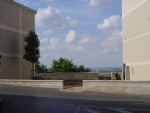 Le square Marquette à
Le square Marquette à
Laon. Le monum...

